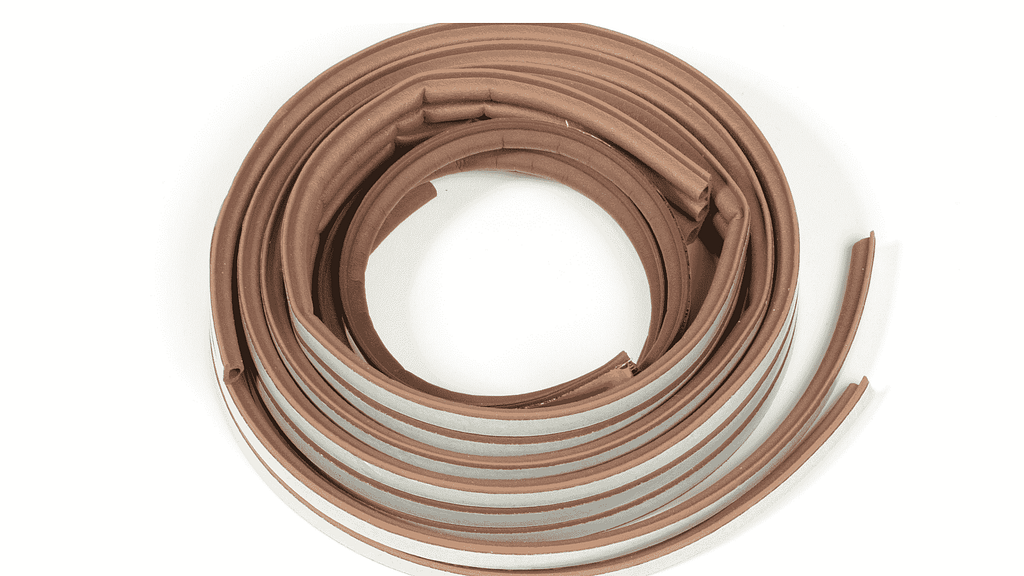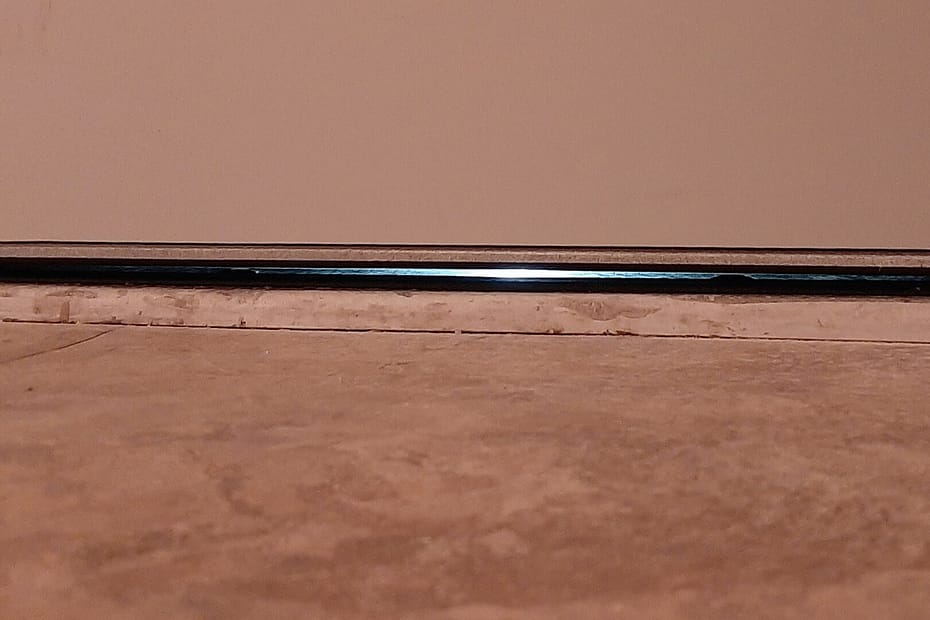Learn to seal a bottom door gap easily. Begin with putting on gloves for safety. Next, get your tools and materials ready. Measure the door sweep and gap for a precise fit, cut the sweep to the right size, and install it.
Table of contents
Common Reason for Door Gaps

Understanding why a gap has formed at the bottom of your exterior door is the first step towards a successful fix. Here are some of the most common reasons for these frustrating gaps:
Weather and Temperature Changes
Wood and metal, common materials for doors and frames, expand and contract with temperature changes. Over the years, these fluctuations can warp or bend door materials, resulting in gaps. Extreme weather conditions, like intense heat, cold, or humidity, can accelerate this process.
Wear and Tear
Regular use of doors can lead to wear and tear. Hinges may become loose, or the door itself might experience damage, affecting how it sits in the frame. The repeated opening and closing of the door can gradually change its alignment, leading to the formation of gaps.
Incorrect Installation
Sometimes, the issue stems from the initial installation. If the door wasn’t properly aligned or if the wrong size was installed, gaps can appear. This is a more common issue in newer constructions or after a door replacement.
If you’re looking to fix the gaps at the bottom of your doors without doing it yourself, or if you’re considering getting a new door because of incorrect installation, you can contact Madison Door. They provide the perfect doors for what you need, made from top-quality materials, and they’ll install them for you professionally.
Safety Precautions
Safety should always be a priority when undertaking any home improvement project. One important safety measure is wearing protective gloves throughout the process. Installing a door sweep can involve handling sharp tools, rough materials, and sometimes metal components. Gloves protect your hands from cuts, abrasions, and splinters, especially when cutting the door sweep to size or adjusting the door.
Tools and Materials Needed
- Aluminum and Vinyl Flange Door Sweep (You can find this door sweep at Home Depot or other local hardware stores.)
- Utility Knife
- Measuring Tape
- Drill
- Hacksaw
- Pencil
- Combo square
- 1 inch self-tapping screws(for steel doors)
Preparation
Before you install a new door sweep, it’s crucial to start with a clean surface. A properly cleaned door ensures better adhesion and effectiveness of the door sweep. Begin by removing any loose dirt or debris from the door and its threshold. You can use a broom or a vacuum cleaner for this. Pay special attention to the bottom edge of the door and the area where you’ll install the sweep.
First, mark the jam location on the door slab with a pencil measure the space between the marks carefully then transfer the measurements to the aluminum and vinyl flange door sweep and make a straight line at the mark with the combo square.
Next, carefully cut the aluminum layers with a hacksaw then cut the vinyl flange with a utility knife. Now, you’re ready to put on your door sweep
Installation
The aluminum and vinyl flange is a semi-rigid sweep, Simply mount to the bottom of your door to create a gentle seal. You can mount them to almost any door quickly and easily.
Close your door and push the sweep against the bottom. Press hard until the rubber bends and the gaps are gone. Then, use a pencil to mark where the screws will go. Use a drill to make holes for the screws that came with the sweep. These supplied screws are for wooden and vinyl doors. If your door is metal, use 1 inch self-tapping screws to fix the sweep in place.
If there are still small gaps at the sides because the door is uneven, add another piece of the sweep to the outside of your door. Choose a longer piece to make sure it covers all the gaps.
You can also check out this YouTube video it shows how to install the aluminum and vinyl flange door sweep.
Prolonging the Life of Your Door Seal
After installing your door sweep or other sealing solutions, it’s important to take steps to maintain them. Regular upkeep not only prolongs the life of your door seal but also helps prevent future gaps from forming. Here are some simple tips to follow:
- Regular Cleaning: Dirt and debris can accumulate on your door sweep and around the door frame. Clean these areas regularly with a soft cloth or brush to prevent buildup. This helps the door seal remain effective and reduces wear and tear.
- Tighten and Adjust as Needed: Over time, the door sweep or seal may become loose. Check the screws or fasteners occasionally and tighten them if necessary. If you notice the seal slipping or not fitting as snugly as before, make the needed adjustments.
- Check for Wear and Tear: Periodically inspect the door seal for any signs of damage like cracks, tears, or looseness. Catching these issues early can mean a quick fix rather than a full replacement.
Alternative Solutions

If you’re looking for a fast and easy way to deal with a gap at the bottom of your exterior door, weather-stripping and draft stoppers are excellent temporary solutions. They’re simple to use and can be very effective in a pinch.
Weather-stripping
This is a flexible material that you can stick or nail around your door to close gaps. It comes in various forms like foam, rubber, or vinyl. To use it, simply measure the length of the gap and cut a piece of weather-stripping to fit. Then, peel off the backing (if it’s self-adhesive) or nail it into place. It’s a quick way to block drafts and can be easily replaced when worn out.
Draft Stoppers
Draft stoppers are like small pillows or tubes made of fabric and filled with insulating materials. They are placed at the bottom of the door to stop drafts. You can buy them or even make one at home using old fabrics and filling them with materials like rice or polyester stuffing. Just place the draft stopper against the bottom of the door whenever you need it, and move it away when you don’t.
Both these methods are great for immediate relief from drafts. They’re especially useful if you’re in a rental property or waiting for a more permanent fix.
Importance of Sealing Bottom Gaps for Your Exterior Door

Sealing gaps at the bottom of exterior doors is not just a matter of aesthetics; it plays a crucial role in maintaining the integrity and efficiency of your home. Here are the key reasons why addressing these gaps is essential.
Energy Efficiency and Cost Savings
One of the most immediate benefits of sealing door gaps is improved energy efficiency. Gaps allow the outside air to enter and conditioned air to escape, making your heating or cooling system work harder to maintain a comfortable indoor temperature. By sealing these gaps, you can reduce energy consumption, leading to significant savings on your utility bills.
Pest Prevention
Even small gaps can be an open invitation to insects and small rodents. These pests can enter your home seeking food, warmth, or shelter. Sealing the gaps not only keeps out drafts but also helps in maintaining a pest-free environment.
Noise Reduction
Sealing gaps can surprisingly contribute to a quieter home. These gaps can act as a conduit for outside noise, and sealing them helps reduce the intrusion of traffic sounds, neighborhood noise, and other external disturbances.
Moisture Control
Gaps at the bottom of doors can allow moisture to seep in, especially during rainy weather. This moisture can damage your floors and lower the air quality inside your home. Over time, it can also contribute to the growth of mold and mildew, posing health risks and structural issues.
Conclusion
In conclusion, fixing a gap at the bottom of an exterior door is more than just a cosmetic fix; it’s a necessary step for home maintenance. Whether you choose a permanent solution like installing a door sweep or opt for temporary fixes like weather-stripping and draft stoppers, the benefits are clear. Not only do you enhance your home’s energy efficiency and comfort, but you also protect it from pests, noise, and moisture.
Remember, the process starts with simple steps – wearing safety gloves, preparing your tools, and ensuring precise measurements for a snug fit. Regular maintenance of your door seal, like cleaning and checking for wear, will prolong its effectiveness. With these tips and techniques, you can easily tackle this common household issue, ensuring a safer, more comfortable living environment for you and your family.
Fact checked by Adrian Catalico 1/25/2024
